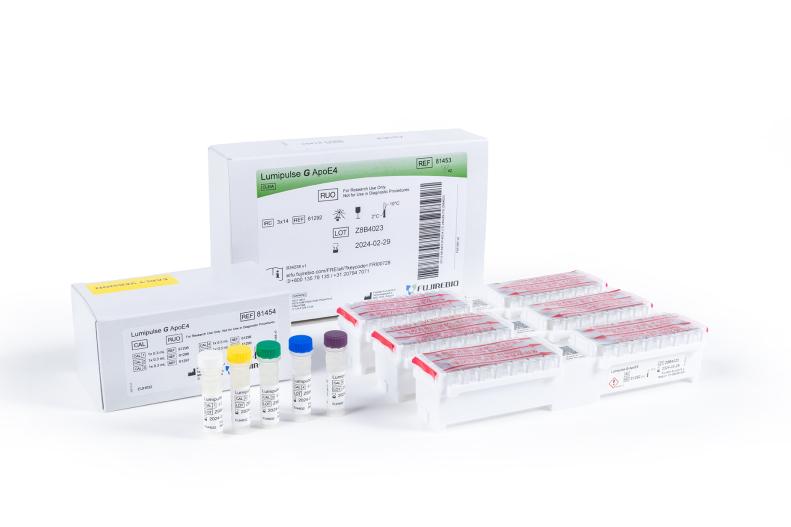Lumipulse® G ApoE4
Immunoassay to be used with the automated LUMIPULSE G System for the quantitative measurement of the E4 isoform of the apolipoprotein E (ApoE4) in human plasma. This product is not for use in diagnostic procedures, for ‘Research Use Only’. This product is for professional use only.
Product number 81453
Product number 81454
Click here to navigate
- Contact sales for information
- Details
- Conditions of sale
- Citations
- Documentation
- Insights
- Product inquiry
- Related products
- Webinars
-
Details
Apolipoprotein E (ApoE) is a polymorphic glycoprotein which plays a role in the transport and metabolism of triglyceride-cholesterol and is known to be synthesized in the liver, brain and other organs. It is encoded by the APOE gene, which has three different alleles (ε2, ε3, ε4) that encode for three different ApoE protein isoforms (ApoE2, ApoE3, and ApoE4). A combination of these isoforms results in 6 phenotypes (3 homozygous types (E2/E2; E3/E3; E4/E4) and 3 heterozygous types (E2/E3; E3/E4; E2/E4)).1,2
When used in conjunction with the Lumipulse G Pan-ApoE assay to determine the ApoE4/Pan-ApoE ratio, this ratio can be used to determine the ApoE proteotype status related to ApoE4, meaning absence (null) or presence of ApoE4 only (homozygous) or the combination with ApoE2 or E3 (heterozygous).
The assay reflects the ApoE4 protein expression level rather than the genotype, as evidenced by the observation that liver transplanted patients have the phenotype of the donor.3
See the LUMIPULSE G1200 working in this video:
References:
- Emi M, et al. Genotyping and sequence analysis of apolipoprotein E isoforms. Genomics, 3(4): 373–379, 1988.
- Utermann G, et al. Genetics of the apolipoprotein E-system in man. Am J Hum Genet, 32(3): 339-347, 1980.
- Linton M, et al. Phenotypes of apolipoprotein B and apolipoprotein E after liver transplantation. J Clin Invest, 88(1): 270–281, 1991.
-
Conditions of sale
To read the end user conditions of sale for this product please visit our Resource center.
-
Citations
The BIOZ badges associated with Fujirebio products include peer-reviewed citations derived from scientific studies using Fujirebio products. Please note that the peer-reviewed citations do not reflect the regulatory status of Fujirebio products. Users should refer to the specific product documentation and any (clinical) claims made therein in order to ensure compliant use. For each country or geographic region, users must verify the related regulatory status of the Fujirebio product.
-
Documentation
Browse regulatory documents for this product
Create a (free!) eServices account and start browsing all product documentation right away.
Get access to this section and more
Create a free eServices account now and instantly access multiple digital resources:
- Product documentation
- Selected scientific posters
- Product leaflets
- How-to videos and more…
-
Insights
Jul 23, 2025Fujirebio introduces its Neuro Expert Toolbox (NExT) at AAIC 2025
Fujirebio is introducing its Neuro Expert Toolbox (NExT) for the first time at AAIC 2025 (Alzheimer's Association International Conference®) in...
Nov 13, 2024Video - Alzheimer's awareness redefined
Follow the journey of the Sullivan family and leading Alzheimer’s Neurologist and Researcher Dr. David Greeley as they introduce and explain these...
Feb 20, 2024Publication - Serum and cerebrospinal fluid neurofilament light chains measured by SIMOA™, Ella™, and Lumipulse™ in multiple sclerosis naïve patients
We would like to draw your attention to a first publication on our Lumipulse® G NfL solution. In this article you will find a method comparison of CSF...
-
Product inquiry
-
Related products




















